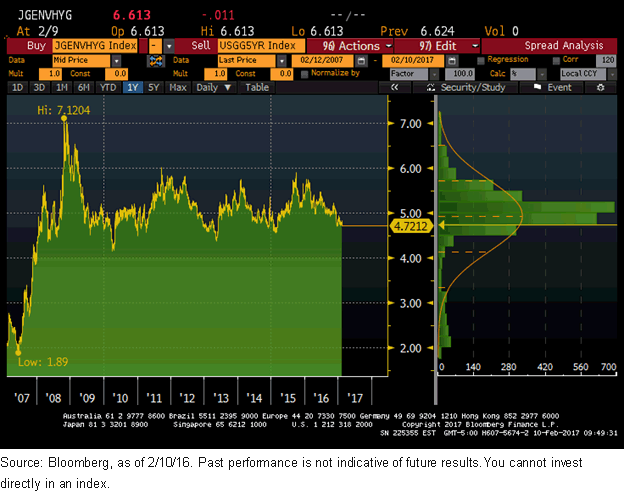Global Fixed Income: What Is "Emerging"?


Following the U.S. election, most of the attention in the fixed income arena seemed to be paid to rate developments here at home, as bond investors found it increasingly difficult not to focus on the twin pillars of domestic policy (monetary and fiscal) creating a more challenging domestic fixed income setting in 2017. Obviously, such policy considerations can have global ramifications as well, so we thought it would be useful to provide some updated thoughts on what has been “emerging” thus far.
Emerging market debt (EMD) certainly had moments of volatility in 2016. To be sure, during the “risk-off” period in the first quarter, emerging market (EM) spreads in local terms (measured as the difference between the J.P. Morgan EM Global Diversified Composite Yield to Maturity vs. the U.S. Generic Government 5-Year Yield) reached a high of +575 basis points (bps) before falling to a pre-Brexit vote low of +498 bps in late April. As expected, EMD could not escape post-Brexit anxieties either, as spreads once again widened back out to +545 bps before settling into more of a range-bound pattern leading up to U.S. election. As in most other fixed income arenas, EMD also responded negatively after the U.S. election, once again piercing through the +500 bps threshold. However, this move to wider ground was not long-lived, with EMD finding its footing; in local debt terms, EMD finished 2016 with a total return just under +10% (J.P. Morgan Government Bond Index-Emerging Markets Global Diversified Index), one of the best performances within all of global fixed income last year.

So, how is 2017 shaping up so far? Six weeks into the new year and EM local debt has thus far produced a positive return of +3.6%, with spreads at +472 bps. As the graph above reveals, from a historical perspective, current spread levels are not too far removed from the 10-year average tally of + 492 bps, as of this writing.
In our 2017 Outlook On the Markets, we stated that many EM central banks face an interesting dilemma in 2017. Economic fundamentals argue that policy can be eased to foster further economic growth in the face of low inflation, but will EM central bankers have confidence in the resilience of their currencies to cut rates as the Federal Reserve (Fed) is hiking them? In our base case scenario, EM currencies could prove very resilient, as higher carry and strengthening EM growth counter a modest move higher in U.S. interest rates. Differentiation within EM will continue to remain important, especially against the potential uncertain trade backdrop from the Trump administration. We should note that in the more extreme risk-off and rising-rate environments, EM currencies could face much greater challenges.
Conclusion
Investors looking to add EM local debt exposure to their fixed income portfolios should consider the WisdomTree Emerging Markets Local Debt Fund (ELD), which invests primarily in local currency debt of emerging market issuers. In an effort to boost allocations to issuers pursuing monetary and fiscal discipline and reduce allocations to those who are overextended, countries are ranked into three tiers and then equally weighted. In addition, country exposure to such factors as growth, inflation, debt capacity/debt service and short-term liquidity are continuously evaluated. Within a fixed income portfolio, ELD can be used to help increase yield as a non-core allocation.
Important Risks Related to this Article
Fixed income investments are subject to interest rate risk; their value will normally decline as interest rates rise. In addition, when interest rates fall, income may decline. Fixed income investments are also subject to credit risk, the risk that the issuer of a bond will fail to pay interest and principal in a timely manner or that negative perceptions of the issuer’s ability to make such payments will cause the price of that bond to decline.Investments in emerging, offshore or frontier markets are generally less liquid and less efficient than investments in developed markets and are subject to additional risks, such as risks of adverse governmental regulation and intervention or political developments.


